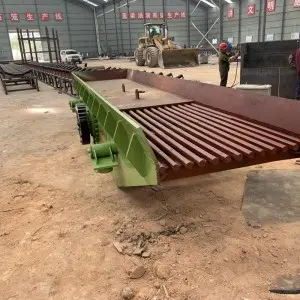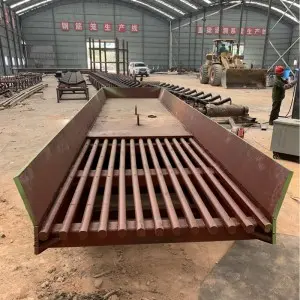In the crushing and screening production line, the vibrating feeder is like the “throat” of the entire system. Its feeding performance directly determines the efficiency of the subsequent crushing equipment and the quality of the finished product. The ZW series vibrating feeder, as a key equipment widely used in the industry, demonstrates significant advantages in achieving uniform and continuous material transportation with its unique structural design and working principle. This article will deeply analyze the technical characteristics of the ZW series vibrating feeders, explore how they achieve stable feeding effects through scientific design, and discuss the core elements that need to be paid attention to in practical applications.
First, the core of feeding stability: vibration principle and energy transfer
The uniform feeding capacity of the ZW series vibrating feeder stems from its precise control and scientific transmission of vibration energy, a process involving the synergistic effect of multiple physical fields.
The energy advantage of the dual-mass resonance system: The ZW series adopts a dual-mass resonance design, forming a coupled vibration system between the vibrating body and the exciter through elastic elements. When the equipment is in operation, the centrifugal force generated by the exciter is amplified through resonance, enabling the material to achieve a stable throwing strength. Test data shows that the energy utilization rate of this structure is more than 35% higher than that of the non-resonant design. Under the same power, it can control the fluctuation of material conveying speed within ±2%, laying a foundation for uniform feeding.
The scientific design of the directional vibration trajectory: The vibration trajectory of the equipment adopts an optimized forward rotation curve, with the amplitude range strictly controlled within 3-5mm and the vibration frequency maintained at 960-1450 times per minute. This parameter combination enables the material to advance in an orderly and leapfrog manner during the conveying process, which not only avoids local accumulation caused by sliding friction but also ensures that the amount of material passing through per unit time remains constant. High-speed camera analysis shows that for the feeder with this trajectory design, the thickness deviation of the material layer can be controlled below 5%.
The dynamic response of excitation force regulation: The adjustable exciter equipped in the ZW series enables operators to adjust the excitation force in real time according to the characteristics of the material. By changing the Angle between the eccentric blocks, the excitation force can be adjusted steplessly within the range of 30% to 100% of the rated value, and the response time is less than 2 seconds. This flexibility enables it to quickly adapt to the conveying requirements of materials with different densities and particle sizes, and maintain a stable feeding rhythm even when the material composition fluctuates.
Second, structural optimization: Ensuring the hardware foundation for continuous feeding
The structural design of the ZW series vibrating feeder fully takes into account the material flow characteristics and equipment durability, and ensures the reliability of long-term continuous operation through multi-dimensional optimization.
The fluid mechanics application of the tank design: The tank adopts a variable cross-section streamlined design. The width of the feeding end and the width of the discharging end form a gradient ratio of 1:0.8. Combined with an installation inclination Angle of 10°-15°, the material forms a uniform flow state under the dual action of gravity and vibration force. The wear-resistant lining plates inside the tank adopt arc-shaped transitions, avoiding material retention caused by right-angle structures and increasing the material passage efficiency by more than 20%. Under special working conditions, anti-sticking coatings can also be configured to increase the stability of conveying viscous materials by 40%.
The dust-proof and leak-proof design of the sealing system: The bearing housing and the vibrator of the equipment adopt a multi-sealing structure, including a combined design of skeleton oil seals and labyrinth seals, with a protection level reaching IP65. This sealing system can effectively prevent dust from entering, enabling the equipment to maintain stable operation even in an environment with a dust concentration as high as 50mg/m³. Meanwhile, the flexible connection design between the tank and the frame reduces the vibration transmission loss, and the operating noise of the equipment is controlled below 85 decibels.
The rapid maintenance feature of modular components: Key components adopt modular design. The connection between the vibrator and the tank body uses standardized bolt interfaces, and the replacement time can be controlled within 30 minutes. The bearings are high-precision self-aligning roller bearings with a rated life of up to 12,000 hours, which is 50% longer than that of ordinary bearings. This design significantly reduces the downtime for equipment maintenance, maintaining an annual effective operating time of over 8,000 hours, providing a guarantee for continuous production.

Third, material adaptation: Technical strategies for dealing with complex working conditions
Materials of different natures put forward differentiated requirements for feeders. The ZW series achieves precise adaptation to various materials through targeted design.
For coarse-grained materials (50-300mm), the equipment adopts a parameter combination of increasing the amplitude (4-5mm) and reducing the frequency (960-1100 times per minute), using a larger projection force to overcome the friction between particles. For fine particle materials (0-50mm), a small amplitude (3-4mm) and a high frequency (1200-1450 times per minute) setting should be adopted to prevent segregation of the materials. Practical experience shows that this parameter adjustment can keep the conveying uniformity of materials of different particle sizes above 90%.
When the moisture content of the material exceeds 15%, the ZW series can automatically increase the vibration intensity by 10% to 15% by installing a vibration frequency compensation device, thereby offsetting the conveying resistance caused by the increase in material viscosity. Meanwhile, the drainage trough design at the bottom of the tank can promptly remove excess water and prevent the material from clumping inside the tank. When handling materials with high moisture content, the equipment can still maintain a feeding stability of over 85%.
For mixed materials with significant density differences, the equipment adopts a segmented vibration intensity design. The feeding section uses a higher excitation force to rapidly disperse the materials, the middle section maintains stable conveying, and the discharging section appropriately reduces the vibration intensity to ensure uniform discharge of the materials. This design enables the output proportion deviation of mixed materials with a density difference of no more than 2 times to be controlled below 8%.
Fourth, system coordination: Matching logic with crushing equipment
The feeding performance of the ZW series vibrating feeder can only be fully exerted when it forms a good synergy with the subsequent crushing equipment. This compatibility is reflected in multiple technical dimensions.
The dynamic matching equipment for processing capacity is equipped with an intelligent frequency conversion control system, which can monitor the load changes of the crushing equipment in real time through sensors and automatically adjust the feeding speed. When the current of the crusher exceeds the rated value by 10%, the feeding amount will decrease by 15% to 20% within 3 seconds. When the current is 30% lower than the rated value, the feeding amount will be automatically increased to ensure that the crusher always operates within the optimal load range. This dynamic adjustment can increase the processing efficiency of the crushing equipment by 10% to 15%.
When used in conjunction with a jaw crusher, the ZW series can achieve a pre-screening function by installing a grid screen plate, separating the ultra-coarse particles that do not meet the feed requirements and preventing the crusher from getting stuck. The grid spacing can be precisely adjusted according to the size of the feeding port of the crusher, generally 0.8 times the width of the feeding port, ensuring that the particle size qualification rate of the materials entering the crusher reaches over 95%.
The synchronous design of timing control adopts a PLC control system to achieve timing synchronization between the feeder and the crushing equipment. When starting up, the feeder starts with a delay of 10 to 15 seconds to ensure that the crusher reaches the rated speed. When shutting down, stop feeding 30 to 40 seconds in advance to ensure that all materials in the crushing chamber are completely discharged. This timing control can reduce the no-load operation time of the equipment, lower energy consumption by about 10%, and at the same time extend the service life of the equipment.

Fifth, performance optimization: A key measure to enhance feeding efficiency
In practical applications, through scientific installation, commissioning and daily maintenance, the feeding performance of the ZW series vibrating feeder can be further enhanced, achieving long-term stable operation.
When installing and debugging the precise positioning equipment, the levelness deviation should be controlled within 0.1mm/m; otherwise, it will cause the material to tilt to one side, affecting uniformity. The vibration direction Angle should be set between 30° and 45° according to the characteristics of the material. For materials with good fluidity, a smaller Angle should be selected; for viscous materials, a larger Angle should be chosen. The no-load trial operation time after installation should not be less than 2 hours to ensure that the operating parameters of each component meet the design standards.
The key points of daily maintenance include regularly checking the fixation of the eccentric blocks of the exciter. They need to be re-tightened once every 1000 hours of operation. The bearings are lubricated with high-temperature lithium-based grease, which is replenished every 500 hours, with each replenishment being 1/3 to 1/2 of the bearing cavity volume. Check the aging degree of the elastic elements every month. When cracks are found or the stiffness decreases by more than 20%, they should be replaced in time. These maintenance measures can extend the equipment failure interval by more than 60%.
Auxiliary measures for environmental adaptation: In high-temperature environments (exceeding 40℃), a forced cooling system should be installed to keep the bearing temperature below 70℃. When in a low-temperature environment (below -10 ℃), the lubricating oil needs to be preheated to ensure the lubrication effect during startup. For dusty environments, it is recommended to install automatic dust cleaning devices and clean the vibration sensors and control systems weekly to prevent dust from affecting signal transmission.
The ZW series vibrating feeder has successfully solved the problem of uniformity and continuity of material feeding in the crushing production line through the application of scientific vibration principles, optimized structural design and flexible adaptability. Its technical advantages in energy utilization, structural durability and system coordination make it a key device for enhancing the efficiency of the entire production line. Through reasonable installation, commissioning and maintenance, the ZW series vibrating feeder can maintain a stable working state for a long time, providing a reliable guarantee for the efficient operation of crushing production. This is also the core reason why it is widely used in the industrial field.
Post time: Oct-23-2025
